As our nation’s capital, Washington, D.C. is filled with numerous historically significant landmarks, from the White House to the Washington Monument (once the tallest building in the world) and the Smithsonian museums of the National Mall. These buildings, monuments, and memorials are surely all familiar sights, but how much do you really know about them? Here are seven fascinating facts about D.C. landmarks you may not have known.
Look Closely and You’ll See the Washington Monument Has Two Types of Stone
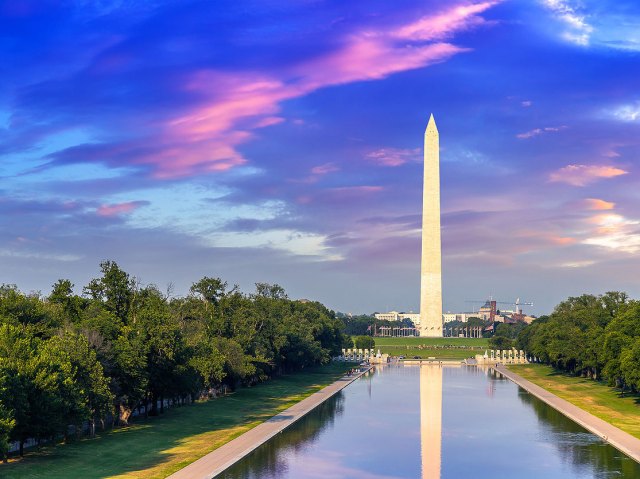
Opened in 1888, the 555-foot-tall monument dedicated to President George Washington is the capital’s tallest concrete structure. But look closely at its stone, and you might notice something askew. Due to funding issues, the initial work on the obelisk had to be paused in 1856. After considerable discussion, Congress deemed the project sufficiently important to use public money, and the build kicked off again in 1876. But there was one problem: The original stone from a quarry in Texas, Maryland, was no longer available. Fortunately, a substitute called Cockeysville marble was found from another Maryland quarry. While the two types of stone initially appeared identical, over time, they haven’t weathered evenly, so visitors can clearly see where one kind ends and the other begins.
An 1829 Inauguration Party at the White House Got Way Out of Hand
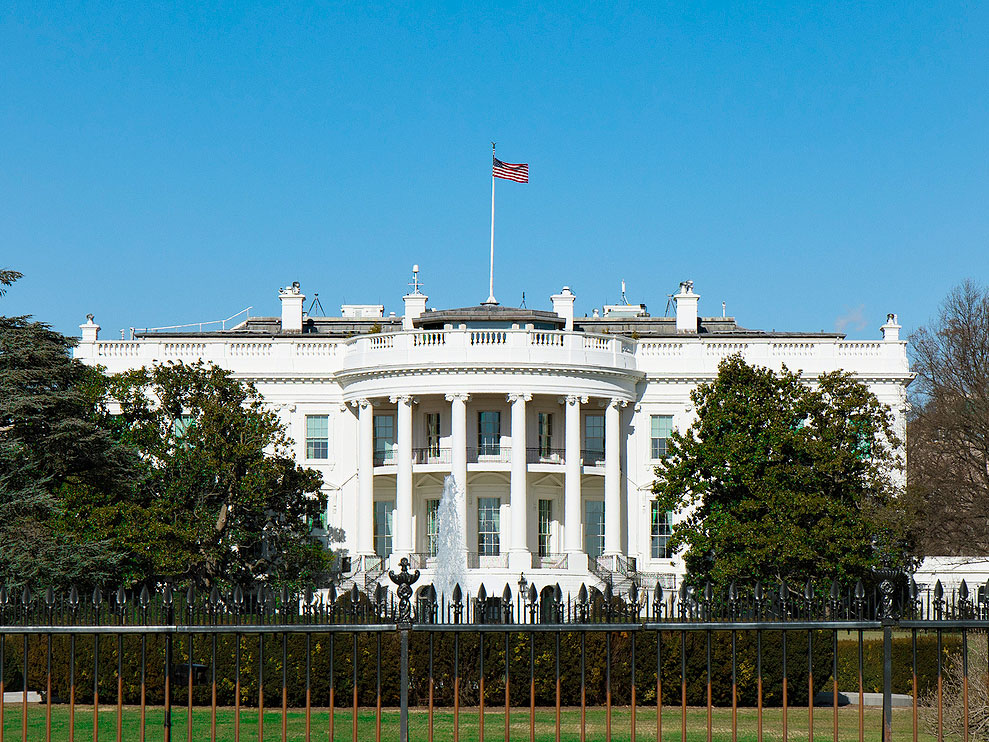
When Andrew Jackson was elected to be the seventh President of the United States, he was considered an outsider, as a military hero from Nashville with limited experience in politics. And Jackson’s first term in office certainly kicked off in an unusual way. After his inauguration in March 1829, he hosted an open house at the White House, as was the tradition at the time, with around 20,000 people in attendance. However, some of the attendees had scant regard for the fixtures and fittings, clambering onto the furniture and leaving muddy footprints over the carpets. Despite the raucous nature of the party, the police weren’t called. Instead, bathtubs filled with orange juice and whiskey were hauled out onto the lawn to entice revelers to follow, while Jackson waited it out in a nearby hotel until it was safe to come back.
There’s a Legendary Demon Cat of the U.S. Capitol
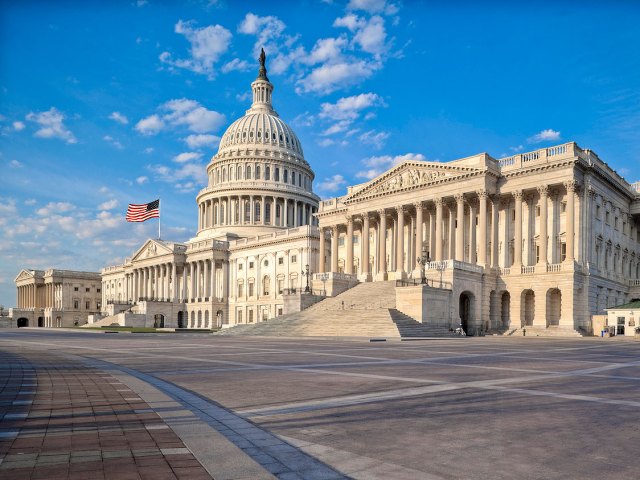
Some believe that the U.S. Capitol is haunted. According to legend, several ghosts reportedly hang out here, including a wounded Civil War soldier who wanders around Statuary Hall and a former Kentucky congressman who’s allegedly been seen in a stairwell. But the most famous legend is that of the grimalkin, a demon cat, sightings of which have been reported since the 1890s. Believers note that the facinorous feline has an uncanny tendency to appear just before something bad happens, such as the stock market crash of 1929 or JFK’s assassination in 1963. There is even a set of paw prints visible in the floor of the Small Senate Rotunda outside the Old Supreme Court Chamber. Of course, there’s a more logical explanation for all of it — perhaps simply a regular cat and some overly impressionable witnesses.
The Lincoln Memorial’s Design Has a Symbolic Meaning

The design of the Lincoln Memorial was a carefully considered one. The Parthenon in Greece inspired Henry Bacon’s vision, as the architect wanted to emphasize the importance of democracy. He also submitted sketches based around Mayan or Egyptian pyramids as an alternative. The final design features Abraham Lincoln’s statue within a building supported by 36 Doric columns, which represent the number of states in the Union at the time of Lincoln’s death. Engraved into the marble above the columns are the names of the 48 contiguous states. You won’t find Alaska or Hawaii, however, as they attained statehood after the building was completed in 1922. Instead, their names feature on a plaque on the front steps.
You Can See the Original (Damaged) Flag From Lincoln’s Box at Ford’s Theatre
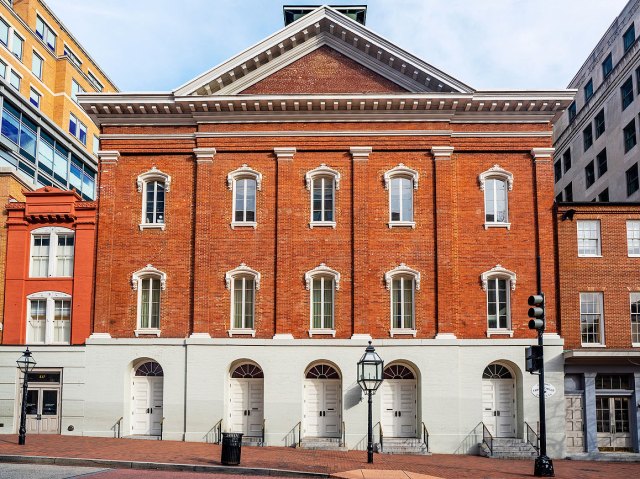
Ford’s Theatre was the site of President Abraham Lincoln’s tragic assassination on April 15, 1865. Actor John Wilkes Booth fatally wounded the President as he watched a performance of Our American Cousin, sneaking into his box and shooting him from behind. In an attempt to flee the scene via the stage, Booth leapt from the box — but in doing so, he snagged his spur on the Treasury Guards’ flag that decorated the box for the President’s visit. The fabric tore and was never mended. Instead, the flag was flown, with the rip clearly visible, as Lincoln’s funeral procession passed the Treasury Building. At the Petersen House across the street from Ford’s Theatre, visitors can still see the original flag. A nylon copy is held at the Office of the Under Secretary of the Treasury for International Affairs, and it, too, has a tear.
Darth Vader Makes an Appearance in the Capital in an Unusual Place
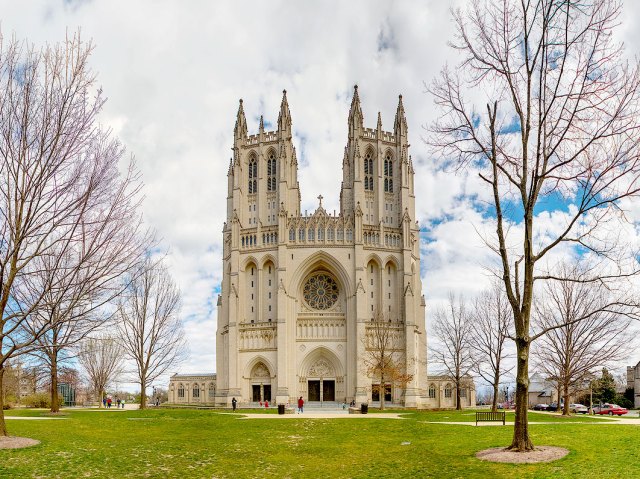
Fans of the Star Wars movie franchise should have the Washington National Cathedral at the top of their D.C. to-do list. Why? This important landmark boasts a surprising bust of Darth Vader high up on the corner of its northwest tower. It’s an example of a grotesque, which differs from a gargoyle in that it deflects rather than drains water. Darth Vader’s position is no accident, nor is it a publicity stunt or the result of a prank. In the 1980s, teenager Christopher Rader entered a national competition for schoolchildren to add a sculpture to a portion of the cathedral under construction. His Star Wars-inspired design was chosen, and stonemason Patrick J. Plunkett turned Rader’s sketch into reality. Some of the cathedral’s other gargoyles are just as quirky, such as one that depicts the Missouri bear holding a miniature Gateway Arch in its paws.
An Extinct Dolphin Was Discovered in the Smithsonian National Museum of Natural History

Many of the world’s top museums have collections that comprise millions of artifacts, often too many to be displayed to the public at any one time. However, one would like to think that museum curators have a handle on what’s in storage. In 2016, two employees at the Smithsonian National Museum of Natural History uncovered a specimen that proved to be quite unusual: a 25-million-year-old skull of a river dolphin that had been found in Alaska. When researcher Alexandra Boersma and curator Nicholas Pyenson took a closer look, they realized no one had actually formally identified the creature before storing it for safekeeping in 1951. Their discovery was classified as Arktocara yakataga, a distant relative of the South Asian river dolphin.
More from our network
Daily Passport is part of Optimism, which publishes content that uplifts, informs, and inspires.























